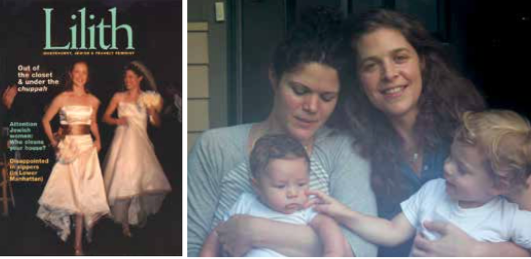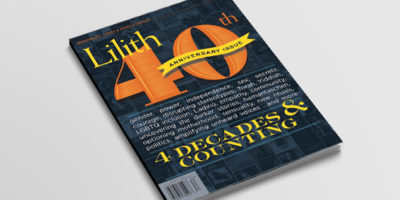
from “Coming Out in the Orthodox World.” And an Update!
One lesbian bridal couple, wanting the blessings both of their parents and of Jewish tradition, managed to meld their religious and gay identities. [Summer 2006] PLUS - The challenge shifts from the deeply personal to the broadly communal: Where does a Jewish and queer family fit? [Fall 2016]
 I never could have imagined a commitment ceremony for me and my partner, or dreamt that our parents would willingly and lovingly host a magnificent celebration for 165 relatives and friends. This would have been, sadly, only a fantasy. Six years earlier I’d thought of ending my life because I was in love with a woman and could not tell a soul. I felt my only other option was to hide, so I reined in all of my emotions. Arielle and I shut out all family and close friends, trap- ping ourselves in a tiny world closed off from our Jewish communities.
I never could have imagined a commitment ceremony for me and my partner, or dreamt that our parents would willingly and lovingly host a magnificent celebration for 165 relatives and friends. This would have been, sadly, only a fantasy. Six years earlier I’d thought of ending my life because I was in love with a woman and could not tell a soul. I felt my only other option was to hide, so I reined in all of my emotions. Arielle and I shut out all family and close friends, trap- ping ourselves in a tiny world closed off from our Jewish communities.
How did we arrive at a destination marked by acceptance and celebration when we began on a road of aversion and shame? I grew up in a modern Orthodox community whose members shared a belief system that dictated the norms of education, marriage, family life and career. Some people held socially conservative opinions and some were more liberal, but when it came to relationships and marriage, there was no dispute: the heterosexual model reigned supreme, with its single archetype for lovers.
Arielle and I first met in high school. Then, at Barnard, we found ourselves performing together in a troupe of singers. Hours of rehearsals and performances gave us time to become close friends. Each of us had men in our lives, but our pull toward closeness pushed away any prospects these other relationships might represent.
Soon we were calling each other at night leaving inconsequential messages, with coy laughter and excited voices. She invited me to breakfast in the dining hall, and I asked her to join me in the library for a night of studying. We proceeded to fall in love, and with each step we took towards each other, we stepped away from those closest to us. I had fallen in love with a gorgeous, tender- hearted, exciting woman, but was not bold enough to tell anyone. I repeated to myself that I was not gay, but that I had fallen for a person who just happened to be female. I couldn’t stomach the truth; the thought that I could be gay flooded me with guilt, shame, and self-loathing. I assured myself that this relationship was just an exception. After all, I had found men physically desirable in the past; they just hadn’t excited me in the ways that my girlfriend did. I justified our relationship by telling myself that I was following my heart, and by doing so acting in a noble manner that somehow excused the gay “part.” I continued to feed myself this mantra of self-denial which only served to push away what I knew deep down to be true: that I was gay and thus undeniably different from everyone around me.
What was I to do with a love that would never be accepted by my Jewish community? How could we walk hand in hand to shul—in Arielle’s community or my own—without causing a scandal and upset- ting the very balance of the universe? I wondered if it would ever be possible to exist as the only openly gay couple in a community of hundreds. Would I be forced to choose between a gay relationship and Judaism?
With my immediate family I had a doable task. The community, on the other hand, was made up of hundreds, each with their own set of exposures and biases.
I was eager to show people that there was nothing to fear from my loving a woman, nothing to fear by our behaving as a couple. Take dancing for example. Dancing at Jewish weddings. There is nothing as conspicuous as dancing in the center of the room with one’s partner. Dancing is what Arielle and I used to gauge our level of comfort in a crowd. From the time we tentatively walked to the dance floor holding hands, eyes were on us, the two femme women who were coupled off. People’s stares seemed to ask, “Could it be? Am I understanding this correctly?” And if ever any guests doubted whether we were actually gay, the slow songs gave them their answer. In our early years together we simply left the dance floor; we equated slow music with “We’re gay but we don’t need to push it in their face.”
Ten years have passed since I wrote in Lilith about coming out in a Jewish world. It’s my role as mother that now defines my life, not my love for a woman.
I’m 40, married and mothering two precious sons with my wife of 11 years. We live in suburbia, close to family, pulled inward by the daily struggles and triumphs of parenthood. In 2015, my lesbian identity came to the fore again as I witnessed federal recognition of gay marriage and felt triumphant having been recognized by my country as an equal. I feel grateful for the ways in which my children, my wife and I can operate comfortably as a family in the public sphere.
But when I think about whether or not my lesbian identity has kept me outside of communal walls, it is Jewish communities that come to mind. A few years back, my elementary school erased my wife’s name from a profile I had sent them for their alumni publication. They simply deleted her from my lines and, in so doing, crushed my spirit and sense of inclusion in that community. Four years ago, after the birth of our first son, my parents’ synagogue refused to announce his birth using both my name and my wife’s name. This time not only was my spirit crushed, but my mother’s as well. These were not sloppy omissions, but were carefully deliberated decisions that succeeded in sending their very forceful message: We are not ready to acknowledge or accept your family as it is.
My parents’ synagogue, for example, the very one that shaped my Jewish identity in childhood and welcomed me as a bat-mitzvah, will not allow us to join as a family. It isn’t anger that animates me in contemplating this truth, but my understanding that I must agitate for change. I say this fully understanding the opposing perspective; the very one that portrays the problematic nature of full communal inclusion as condoning a gay “lifestyle.” I’ve written about the term “gay lifestyle,” explaining that it isn’t my gayness that defines my lifestyle, but rather the complex make-up of education and upbringing that has shaped my values. My wife and I have chosen to remain connected because our Jewish identity remains part of our core, a part of us we hope to pass along to our children. We’re not looking to transmit Jewish values and traditions in a vacuum, but within a community that both accepts us and can boast signs of true inclusivity. One that can offer us other same-sex couples, other toddlers and infants with two mothers or fathers. The problem is not that families like ours do not exist, but they’ve taken themselves out of Jewish spheres. It is the essential challenge to LGBT Jews: finding a Jewish community with genuine inclusivity. A school worthy of our children is one in which they see themselves and their families reflected back, an institution that will not challenge us to explain our family.
Our sons’ having two mothers does make them different. Expressing this as a “non-issue” reflects a lack of understanding about what queer families need to thrive. In certain ways, our boys are traveling on a different road from many of their peers. And it is acknowledgment of that road that we’re looking for, especially as school becomes a larger presence as they grow. We want our sons to find their place in the heart of a community, not at the periphery. And even when children with two mothers or two fathers are in our Jewish schools in greater numbers, this alone will not be enough. It is how these children are treated and spoken to, and how their families are spoken about in and out of the classroom, that matters most. It is how curricula adapt to accommodate families such as our own, and the words that teachers and administrators use.
Believe me, I am aware and very grateful for the day schools that are currently working hard, undergoing the change needed to embrace LGBT families. And I am also aware of the synagogues in our own vicinity that are taking intrepid steps to support and welcome LGBT members. I applaud these institutions and their efforts and realize that they are in the vanguard. And yet, it’s hard to wait for the vanguard to become mainstream. I am hopeful because of organizations like Keshet, working for the full inclusion of the LGBT community in Jewish life. Now it is up to teachers in classrooms and religious leaders in their pulpits to create a truly inclusive environment, not only for LGBT members, but for all.
Without much support from their own community, my parents managed to find what they needed outside the bounds of their hometown, to me, a poignant change in my parents’ continued growth. Some years ago, on Cape Cod during a family vacation, we noticed neighbors were host- ing a lesbian wedding. As we saw the two brides and their guests, my father called over loudly, “Congratulations!” I was gratified to see that my father’s supportive, loving stance was not only for his daughter, but also for a community unknown to him. My mother has always been the more liberal, socially progressive of my parents, but my father has shown me how daring he can be when standing up for LGBT rights and inclusion, delivering bold remarks to his congregation and in local newspapers about the inflexible stance of modern Orthodoxy towards LGBT Jews. Together, my parents have become leaders and peer supporters for many other Jewish parents of LGBT children, and through the organization Eshel they’ve devoted themselves to change nationwide. It’s rather funny, but it is not I—the lesbian with a “gay agenda” —but perhaps my parents who are the change-makers.


